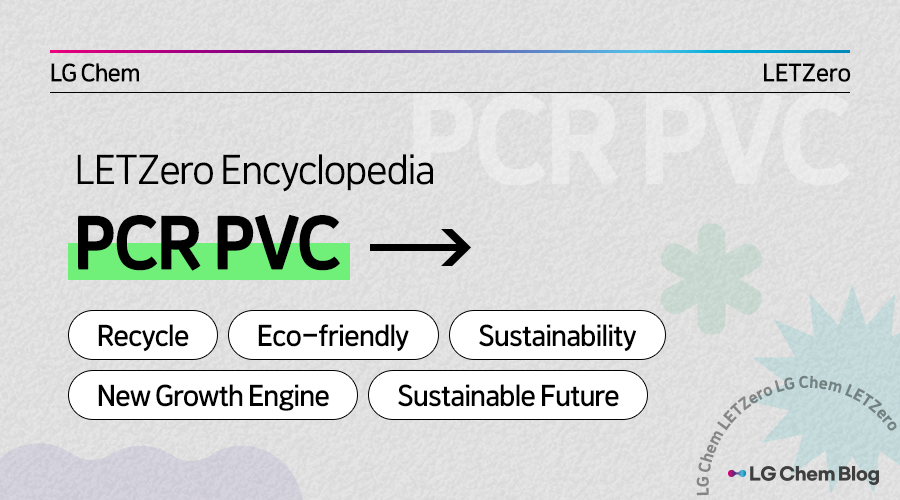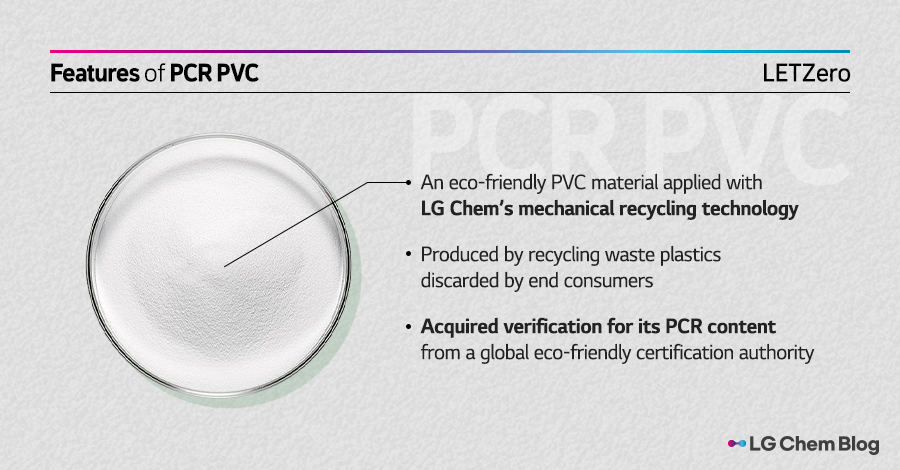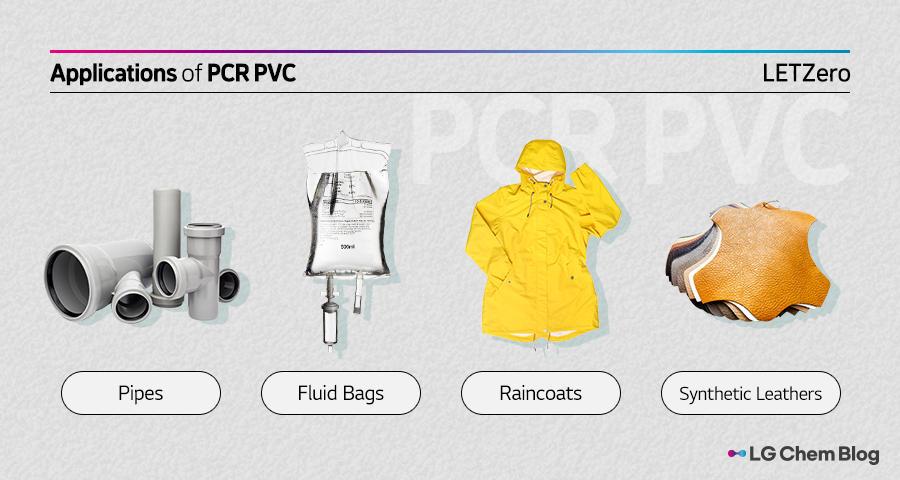LETZero Encyclopedia: PCR PVC – Recycling the typical thermoplastic
2024. 05. 10
LETZero Encyclopedia: PCR PVC – Recycling the typical thermoplastic
2024. 05. 10

Welcome to LETZero Encyclopedia, an introductory series to LG Chem’s eco-friendly brand LETZero and their products. The latest episode introduced Bio-Circular Balanced SBS, an eco-friendly special resin which holds the properties of both plastic and rubber. Today, we focus on the features and usages of PCR PVC, a material developed from recycled raw materials.

First, let’s learn about PVC (Polyvinyl Chloride). PVC is a typical thermoplastic widely used in our daily lives. PVC is a material of many advantages, including excellent durability, corrosion resistance, and chemical resistance. It has high transparency and tintability, making it easy to embody the color you want in various items. Also, it is highly processable, which explains its popularity in diverse fields from construction materials to daily necessities.
Depending on the type of plasticizer used in its development process, the features of PVC such as its solidity or durability, etc. can vary. When applied with a plasticizer or stabilizer, PVC comes with a softer, more flexible properties, gaining the name ‘Flexible PVC.’ On the other hand, PVC without the application of plasticizers have a hard, easily-broken texture, and is called ‘Rigid PVC.’ While flexible PVC is used in soft products such as raincoats, shower curtains, and greenhouses, rigid PVC is used in harder products like pipes, windowsills, and floor materials.

PCR PVC (Post Consumer Recycled PVC) is an eco-friendly PVC material applied with LG Chem’s mechanical recycling technology, using waste plastics discarded by end consumers. What process does the production of PCR PVC follow? First, we separate PVC from waste plastics. Next, the PVC is crushed and cleansed to get rid of contaminants. This state of PVC is called ‘Flakes.’ After that, the flakes are melted into a ‘pellet’ form, similar to a grain of rice, ready to be used as a plastic raw material. Now, the pellets are blended with virgin raw materials with LG Chem’s exclusive recipe and relevant proportion, completing the PCR PVC.
PCR PVC obtained by this process maintains quality equivalent to virgin plastics. Moreover, it contributes to the reduction of carbon emissions. As a response to the rising demand for eco-friendly materials and requests from customers, LG Chem has acquired a global eco-friendly certification for their PCR products. Including UL ECV (Environmental Claim Verification), TUV (German Technical Inspection Association), and GRS (Global Recycled Standard), LG Chem is acquiring verification for their PCR content from different institutions.

Living up to the name of world’s 5-most-widely-used plastics, PVC can be found in every corner of our daily lives. Same goes with PCR PVC, which is applied to wherever traditional PVC is used.
Let’s start with construction materials. Since PCR PVC is rigid, light, and durable, it is used in piping materials, windowsills, wallpapers, and flooring materials. Plus, it is flame retardant and has a superior electrical insulation, suitable for wire clothing. PCR PVC is also popular in healthcare products. Thanks to its cost-efficiency and excellent chemical resistance, it is used to create medical product packaging, surgical gloves, and fluid bags. In daily life, PCR PVC is usually spotted in waterproof items. With excellent corrosion resistance and water resistance, and processability, it is applied to not just raincoats and shower curtains, but also items such as tubes, rafting boats, and beach bags. Besides that, it is also found in various places such as automotive and electronic parts, synthetic leather, play mats, gym balls, etc.
So far, we took a look at PCR PVC. The next LETZero Encyclopedia will come back with a story of PEC.

There are no comments yet! Be the first to let us know your thoughts!